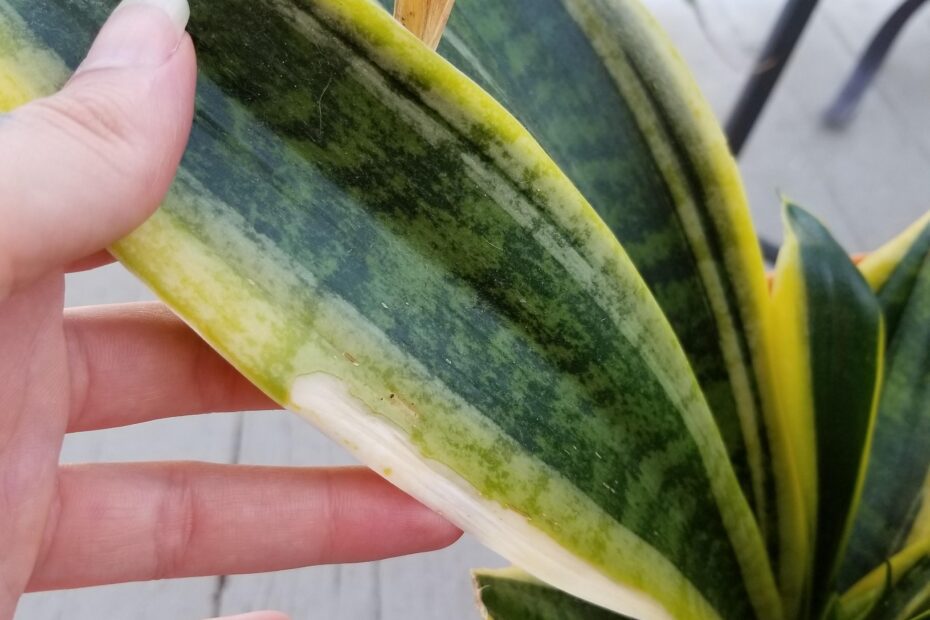A Ghostly Surrender: Unveiling the Mysterious White Symphony of Snake Plants
In the enchanting realm of indoor foliage, few specimens captivate the eye quite like the graceful snake plant. With its sturdy leaves jutting skyward like elegant swords, this verdant beauty has long been a symbol of resilience and charm. Yet, as if conjuring an otherworldly secret, there are times when these leafy sentinels of the plant kingdom take an unexpected stance, mysteriously transforming into a haunting spectacle. As an ardent plant lover, you might find yourself entranced by the question curdling in your mind: “Why is my beloved snake plant turning white?” Fear not, dear reader, for we embark on a neutral quest today, to shed light on this enigmatic phenomenon and bring forth the secrets hidden within the pale tapestry of your beloved foliage. Prepare to step into a world where nature dances with the unknown, where snake plants transform into ethereal spectacles, igniting both curiosity and wonder in every leafy tendril.
Reasons for the White Appearance of Snake Plant Leaves
Snake plants, also known as Sansevieria, are beloved houseplants due to their low-maintenance nature and striking appearance. However, it’s not uncommon for snake plant leaves to develop a white coloration, which can be quite puzzling for plant enthusiasts. There are several reasons why your snake plant may be displaying this unexpected white hue.
One potential explanation is sunburn. Snake plants are known for their tolerance to low light conditions, but they can also be sensitive to direct sunlight. If your snake plant is exposed to intense, direct sunlight for prolonged periods, the leaves may become bleached and turn white. To remedy this, consider moving your plant to a spot with indirect or filtered sunlight, or providing a sheer curtain to filter the sun’s rays.
Another possible cause of white snake plant leaves is nutrient deficiency. Like all plants, snake plants require certain nutrients to thrive. Insufficient levels of essential macronutrients such as nitrogen, phosphorus, and potassium can result in leaf discoloration. Ensure that you are using a balanced fertilizer specifically formulated for houseplants, and follow the recommended dosage instructions to provide your snake plant with the necessary nutrients for healthy growth. Remember, over-fertilizing can also lead to leaf discoloration, so moderation is key.
Here are some features and tips to keep in mind when caring for your snake plant:
| Features | Tips |
|---|---|
| Resilient and low maintenance | Water sparingly and let the soil dry out between waterings |
| Ability to purify indoor air | Keep away from drafts and cold temperatures |
| Tolerant of low light conditions | Avoid overwatering to prevent root rot |
In conclusion, if your snake plant leaves are turning white, it’s crucial to assess the potential causes and take appropriate steps to address the issue. Whether it’s excessive sunlight exposure or nutrient deficiency, understanding the reasons behind the white appearance of your snake plant leaves will help you provide the necessary care for your beloved houseplant. With proper attention and maintenance, your snake plant will soon regain its vibrant green color, adding a touch of natural beauty to your living space.
Understanding the Role of Lighting in Snake Plant Discoloration
When it comes to our beloved snake plants, it can be disheartening to see their vibrant green leaves gradually turn white. As snake plant enthusiasts, we yearn to understand the underlying causes behind this unwelcome change. Fear not, for today we delve into the enigmatic role of lighting in snake plant discoloration, uncovering the secrets that hide within the shadows.
-
Natural Light vs. Artificial Light: Snake plants thrive in bright but indirect sunlight. Too much direct sunlight can scorch their leaves, resulting in discoloration. On the other hand, insufficient light may cause their leaves to lose pigment, leaving them pale and frail. Striking the right balance is key!
-
Duration of Light Exposure: Snake plants have a preference for moderate amounts of light during the daytime. Continuous exposure to light for extended periods may lead to discoloration. Let them indulge in some darkness too, as they require a break from the spotlight to rejuvenate and maintain their vibrant appearance.
Features Tips
Leaf Color: Avoid placing snake plants in areas with direct sunlight, as it may cause their leaves to turn white.
Light Intensity: Ensure that snake plants receive bright and indirect light to prevent discoloration.
Light Duration: Give your snake plant some darkness by providing periods of light and darkness to maintain its color vitality.
In our quest to understand the snake plant’s discoloration, lighting plays a significant role that should not be underestimated. By following these tips and providing the optimum lighting conditions, we can help our snake plants thrive, ensuring their leaves retain their captivating shade of green. Illuminate their world wisely, and witness their beauty flourish!
Identifying Possible Pests and Diseases Causing White Spots on Snake Plant
Snake plants, also known as Sansevieria, are prized for their hardy nature and beautiful leaf patterns. However, when those vibrant leaves start developing unsightly white spots, it can be a cause for concern. In this post, we will explore the possible pests and diseases that could be causing this phenomenon and provide some tips on how to address them.
One common culprit behind white spots on snake plants is mealybugs. These pesky little insects are tiny, white, and hide in the nooks and crannies of the leaves. Mealybugs feed on the plant sap, causing the affected areas to turn white. To combat these unwelcome visitors, it’s crucial to act promptly. Begin by inspecting the plant thoroughly, paying attention to the undersides of leaves and leaf axils. If you spot mealybugs, remove them manually using a cotton swab dipped in rubbing alcohol. Additionally, consider using organic pesticides specifically formulated to eradicate mealybugs.
Another potential cause for white spots on snake plants is powdery mildew. This fungal infection manifests as a powdery white coating on the leaves, often accompanied by distorted growth. To tackle powdery mildew, maintain good airflow around the plant by spacing them adequately. Avoid overwatering, as damp conditions favor the growth of this fungus. If your snake plant already has powdery mildew, carefully trim away the affected leaves and dispose of them. Then, treat the remaining foliage with a horticultural oil or a fungicidal spray to prevent any further spread of the infection.
Here are some features or tips on how to maintain a healthy snake plant:
| 1. | Ensure the plant receives sufficient indirect sunlight. |
| 2. | Avoid overwatering and allow the soil to dry out between waterings. |
| 3. | Regularly inspect the plant for pests or signs of disease. |
Remember, prevention is always better than cure when it comes to keeping your snake plant healthy and free from white spots. By being vigilant and following these tips, you can ensure your snake plant remains a stunning addition to your indoor or outdoor space.
Essential Care and Remedies to Restore Green color of Snake Plant Leaves
One of the most common concerns among snake plant owners is the alarming sight of their once vibrant green leaves turning white. This change in color can be quite distressing, as it not only affects the plant’s aesthetic appeal but may also indicate underlying health issues. Don’t worry, though, because in this post, we will uncover the essential care and remedies to restore the green color of your beloved snake plant leaves.
To bring back the luscious green hue, it is vital to understand the potential causes of this discoloration. The most common reason for white snake plant leaves is excessive sun exposure. Snake plants prefer indirect or filtered sunlight, so if you notice your plant bathing in direct sunlight for long durations, it’s time to find it a shadier spot. Another possible culprit behind the pale leaves is soil moisture. These plants thrive in well-draining soil, so ensure that you are not overwatering them or letting them sit in standing water. Remember, a little neglect goes a long way when it comes to snake plants’ watering needs.
Here are some features and tips that can aid you in restoring the gorgeous green color of your snake plant leaves:
| 1. Adjust lighting conditions | 2. Optimal watering routine |
| Ensure your snake plant receives indirect or filtered sunlight to prevent excessive sun exposure. | Stick to a watering routine that allows the soil to dry out between waterings. Overwatering can lead to root rot and discoloration. |
| 3. Provide adequate drainage | 4. Check for pests |
| Ensure the pot has proper drainage holes and remove excess water to avoid waterlogged soil, which can cause leaf discoloration. | Inspect your snake plant regularly for pests like spider mites or mealybugs, as they can also contribute to leaf discoloration. |
By implementing these care techniques and remedies, you can revive the green color of your snake plant leaves and restore its beauty, ensuring a healthy and thriving houseplant for years to come.
Frequently Asked Questions
Q: Why is my snake plant turning white?
A: The Mystery of the Pale Python!
Q: Oh no! My snake plant is losing its vibrant green color—what’s happening?
A: Fear not, curious gardener! Let’s unravel the secret behind the mysterious bleaching of your beloved snake plant.
Q: Why would my once verdant snake plant suddenly go pale?
A: Drifting into Whitlethargia: The Enigmatic Whitening Phenomenon Revealed!
Q: Uh, how can I revive my snake plant’s former glory after it has become white?
A: Unmasking the Ghostly Discoloration: How to Bring Your Snake Plant Back to Life! As you bid farewell to this article, we hope that the mystery surrounding your beloved snake plant’s color transformation has been unraveled. Although the journey of discovering why your once vibrant green companion has taken on a pale, white hue may have been perplexing, remember to approach it with patience and an open mind.
Nature has a way of surprising us, casting a unique glow upon our path just when we least expect it. Perhaps your white-tinged snake plant is unlocking a stunning chapter in its growth story, akin to a literary masterpiece. Soothing and stoic, it now adorns itself in a serene shade, beckoning admiration and curiosity from all who encounter it.
Consider this unexpected change as a gentle reminder that even in the realm of botany, there lies a world of mysteries hidden beneath the surface. In our pursuit of understanding nature’s whims, we embark on a continuous voyage of exploration, a dance between science and wonder.
As you venture forth armed with newfound knowledge and curiosity, remember to monitor your snake plant’s well-being. Pay attention to its watering routine, ensure it basks in optimal lighting conditions, and give it the love and care it deserves. A touch of tender attention can foster an environment where even the white serpent of your indoor garden can flourish with renewed vibrance.
In this circle of life, where we intertwine with the botanical realm, it is our duty to play the role of guardians, protectors of these mesmerizing creatures that bring a touch of nature’s embrace into our homes. By nurturing our green companions, we cultivate a sanctuary that flourishes with life and vibrancy.
So, as you bid farewell to this tale of the mysterious metamorphosis of your snake plant, remember that white is not a mere absence of color but rather a canvas awaiting a masterpiece, a testament to the enigmatic wonders of the plant world. Embrace the transformation, and may your journey into the captivating world of flora be filled with delight, curiosity, and an appreciation for the magic nature offers us all.
- When to Put Weed and Feed on Lawn in Michigan - October 16, 2023
- When to Fertilize Potatoes Plants - October 16, 2023
- Can You Plant Clover in the Spring - October 16, 2023
Contents
- 1 Reasons for the White Appearance of Snake Plant Leaves
- 2 Understanding the Role of Lighting in Snake Plant Discoloration
- 3 Features Tips
- 4 Leaf Color: Avoid placing snake plants in areas with direct sunlight, as it may cause their leaves to turn white.
- 5 Light Intensity: Ensure that snake plants receive bright and indirect light to prevent discoloration.
- 6 Identifying Possible Pests and Diseases Causing White Spots on Snake Plant
- 7 Essential Care and Remedies to Restore Green color of Snake Plant Leaves
- 8 Frequently Asked Questions





